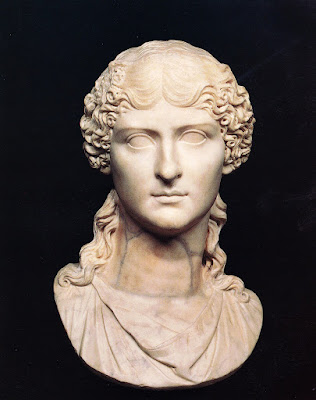Ressenya
Agrippina the Younger (15-59 AD) was the daughter of Germanicus and Agrippina the Elder, sister of emperor Caligula, wife of Claudius and mother of Nero. As a child, she lost her family due to dynastic rights and became aware that the price for the Empire was to kill or to be killed. With great intelligence and intellectual training, she wrote memoirs of her family. She exercised her power skillfully and diplomatically during her son's rise to power, but she was not allowed to make full exercise of it.
Justificacions
- She managed to get her son Nero to be emperor.
- She had the ability and the desire to govern, but, when she did so explicitly, it cost her her life.
- With a great literary training, she wrote memoirs that served as a source for other historians.
Biografia
Agrippina the Younger (15-59) was the daughter of Germanicus and Agrippina the Elder, sister of the emperor Caligula, wife of Claudius and mother of Nero. A woman of great intelligence and intellectual training, she wrote the memoirs of her family.
Agrippina the Younger, or Agrippinilla, had lived through the strange death of her father, general Germanicus, and the exile of her mother, Agrippina the Elder. Agrippina believed that her family's legitimate power should be restored.
Agrippinilla had married in the year 28 with the Roman consul Domitius Ahenobarbus, with whom she did not have a good relationship. Almost ten years passed until her son Nero was born, the future much hated emperor Nero. A short time later, when Agrippinilla was only 25 years old, she was widowed for the first time.
A year later, in the year 41, Tiberius died and named Agrippina’s brother Caligula emperor. After restoring their family's honour, the new emperor gave Agrippina and two other sisters preferential treatment at the imperial court. With the death of their sister Drusilla, the emperor contracted a mental illness and relegated Agrippina and Livilla. Accused of conspiring against him, they were exiled to the Pontine Islands.
After Caligula's murder, the new emperor, their uncle Claudius, lifted the exiles and returned Agrippina and her sister to Rome. Convinced that she should continue fighting for her son, the first thing she did was to marry a millionaire named Passienus Crispus. Short time later he died, according to rumors, poisoned by his own wife.
Widowed again, Agrippina grew closer to her uncle. As empress Messalina dug her own grave by publicly marrying one of her lovers, Agrippina saw a clear path to the throne. Following Messalina's execution, Claudius married his niece Agrippina.
First, she got Claudius to accept the union between his daughter Octavia and Nero; later, Claudius adopted him. While Nero gained ground, Britannicus regressed because his cousin started a smear campaign against him.
In the year 54 AD, Agrippina poisoned Claudius at dinner and Nero, being his adopted son, became emperor. Agrippina was at the peak of her power, but her splendour did not last very long.
Her murder was not easy. Having discarded poisoning as a way to murder his mother, Nero tried to sink the ship in which she was travelling. Agrippina escaped by swimming. Ultimately, the emperor's mother died at her villa in Antium, the very place where she had given birth to him, the person who was now to become her murderer. A sword ended her life.
Ferrer, Sandra (2022). “Asesina y asesinada, Agripina la Menor (15-59)”, in Mujeres en la historia, (retrieved on 22-03-2011).
<https://www.mujeresenlahistoria.com/2011/03/asesina-y-asesinada-agripina-la-menor.html>
Obres
He wrote a Memoirs that served as a source for other historians and which have not been preserved.
Bibliografia
- Cid, Rosa Mª (2014). “Imágenes del poder femenino en la Roma antigua. Entre Livia y Agripina”, Asparkía, nº 25, pp.179-201, (retrieved on 14/05/2021), <https://www.e-revistes.uji.es/index.php/asparkia/article/view/1282/1116>
- Hidalgo, M.ª José (2012). Las emperatrices romanas. Sueños de púrpura y poder oculto. Salamanca: Ediciones Universidad de Salamanca, pp. 46-53.
- Posadas, Juan Luís (2008), Emperatrices y princesas de Roma. Madrid: Raíces.
- Soutthon, Emma. (2019). La primera emperatriz de Roma. Barcelona: Pasado & Presente.
- Torrego, Mª Esperanza (2004). “Agripina la Menor, el poder como obsesión”, en Jesús de la Villa (ed.), Mujeres de la Antigüedad. Madrid: Alianza Editorial, pp.198-224.
- Ferrer, Sandra (2011). “Asesina y asesinada, Agripina la Menor (15-59)”, en Mujeres en la historia, (retrieved on 22/03/2022), <https://www.mujeresenlahistoria.com/2011/03/asesina-y-asesinada-agripina-la-menor.html>
AUDIOVISUAL:
- “Agripina la Menor, o el fuego del poder en la Roma Antigua. Eva Tobalina”, en Raíces de Europa, (retrieved on 11/05/2021), <https://www.youtube.com/watch?v=9nuTUAW5_-4>
Enfocament Didàctic
-CUC: Block Classical roots of today's world. History and socio-political evolution; Block Classical roots of today's world. Everyday life.
-Latin 4 ESO: Block The present of Latin civilisation.
-Latin Baccalaureate: Block Ancient Rome.
-History 1 ESO: Block Societies and territories, referring to Rome.
Documents
